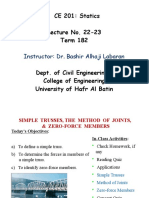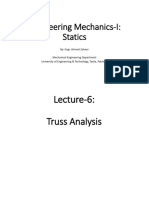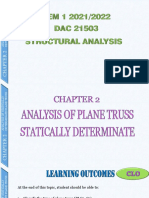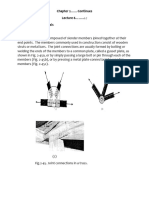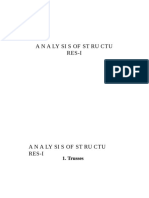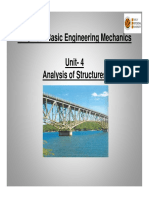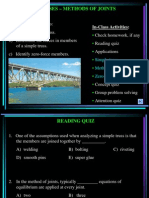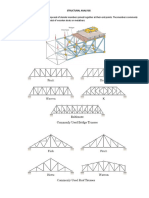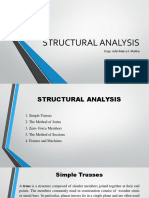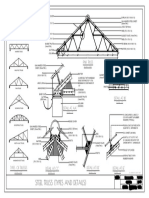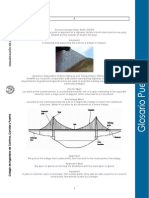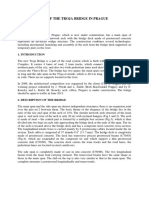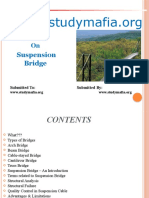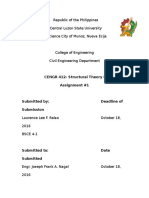Chapter 5
Uploaded by
gericalorrinecapilicabugChapter 5
Uploaded by
gericalorrinecapilicabugSTATICS OF RIGID BODIES
Chapter 5
Analysis of Structures
Table of Contents
5.1 Introduction .......................................................................................................................................... 1
5.2 Analysis of Trusses by the Method of Joints ....................................................................................... 4
5.3 Analysis of Trusses by the Method of Sections ................................................................................ 10
5.4 Frames and Arches ............................................................................................................................. 18
After careful study of this chapter, students should be able to do the following:
1. Define simple and compound trusses.
2. Use the method of joints to calculate forces in truss members by analyzing each joint.
3. Apply the method of sections to find internal forces in specific truss members.
4. Analyze frames and arches.
5.1 Introduction
Analysis of structures deals with problems in the equilibrium of structures made of several connected
parts. It involves determination not only the external forces acting on the structure but also the internal
forces. Internal forces are the forces which hold together the various parts of the structure, from the
point of view of the structure as a whole.
Trusses are designed to support loads and are usually stationary, fully constrained structures. Trusses
consist exclusively of straight members connected at joints located at the ends of each member.
Members of a truss, therefore, are two-force members, i.e., members acted upon by two equal and
opposite forces directed along the member.
Truss members are connected at their extremities only; thus no
member is continuous through a joint. In the truss shown, there
is no member 𝐴𝐵; there are instead two distinct members 𝐴𝐷
and 𝐷𝐵. Most actual structures are made of several trusses
joined together to form a space framework. Each truss is
designed to carry those loads which act in its plane and thus
may be treated as a two-dimensional structure.
In general, the members of a truss are slender and can support little lateral load; all loads, therefore,
must be applied to the various joints, and not to the members themselves.
The weights of the members of the truss are assumed to be applied to the joints, half of the weight of
each member being applied to each of the two joints the member connects.
Although the members are actually joined together by means
of welded, bolted, or riveted connections, it is assumed that
the members are pinned together; therefore, the forces
acting at each end of a member reduce to a single force and
no couple. Each member can then be treated as a two-force
member, and the entire truss can be considered as a group of
pins and two-force members.
1 Chapter 5 MARLON T. ACOBA, MSCE, M.ASEP
Analysis of Structures
STATICS OF RIGID BODIES
The forces tend to pull The forces tend to
the member apart, and compress the member,
the member is in and the member is in
tension. compression.
Typical Roof Trusses
Typical Bridge Trusses
Other Types of Trusses
A plane truss is a truss that lie in a single plane which is used to support roofs and bridges. A simple truss
is constructed from a “base” triangle by adding two members at a time that meet at a new joint, e.g.,
Pratt, Warren, Howe, K truss. A compound truss consists of two or more simple trusses, e.g., Baltimore,
Fink.
2 Chapter 5 MARLON T. ACOBA, MSCE, M.ASEP
Analysis of Structures
STATICS OF RIGID BODIES
The truss is made of four members connected by pins The truss is made of three members
at 𝐴, 𝐵, 𝐶, and 𝐷. If the load is applied at 𝐵, the truss connected by pins 𝐴, 𝐵, and 𝐶, will deform
will greatly deform, completely losing its original only slightly under a load applied at 𝐵. The
shape. only possible deformation for this truss is
one involving small changes in the length of
its members. The truss is said to be a rigid
truss i.e., the truss will not collapse.
A larger rigid truss can be obtained by adding two
members 𝐵𝐷 and 𝐶𝐷 to the basic triangular truss.
This procedure can be repeated as many times as
desired, and the resulting truss will be rigid if each
time two new members are added, they are attached
to two existing joints and connected at a new joint. A
truss which can be constructed in this manner is
called a simple truss.
In a simple truss the total number of members is 𝑚 = 2𝑗 − 3.
Zero-force members in a truss usually arise in one of two general ways:
1. When only two members form a non-collinear truss joint and no external load or support
reaction is applied to the joint, then the members must be zero-force members.
2. When three members form a truss joint for which two of the members are collinear and the third
forms an angle with the first two, then the non-collinear member is a zero-force member
provided no external force or support reactions applied to that joint. The two collinear members
carry equal loads.
Sample Problems
1. For the given loading, determine the zero-force members for the truss shown.
Answers: members 𝐴𝐼, 𝐵𝐽, 𝐶𝐾, 𝐷𝐼, 𝐸𝐼, 𝐹𝐾, 𝐺𝐾
2. For the given loading, determine the zero-force members for the truss shown.
3 Chapter 5 MARLON T. ACOBA, MSCE, M.ASEP
Analysis of Structures
STATICS OF RIGID BODIES
Answers: members 𝐹𝐾, 𝐼𝑂
5.2 Analysis of Trusses by the Method of Joints
The method of joints is based on the fact that if the entire truss is in equilibrium, then each of its joints is
also in equilibrium. The free-body diagram of each joint is used to obtain the member forces acting at the
joint. Since the members of a plane truss are straight two-force members lying in a single plane, each
joint is subjected to a force system that is coplanar and concurrent, hence, only Σ𝐹! = 0 and Σ𝐹" = 0
need to be satisfied for equilibrium.
Procedure for Analysis
1. Draw a free-body diagram of the entire truss and use this diagram to determine the reactions at
the supports.
2. Locate a joint connecting only two members and draw the free-body diagram of its pin. Use this
free-body diagram to determine the unknown force in each of the two members. If only three
forces are involved (the two unknown forces and a known one), it is more convenient to draw and
solve the corresponding force triangle. If more than three forces are involved, write and solve the
equilibrium equations for the pin, Σ𝐹! = 0 and Σ𝐹" = 0, assuming that the members are in
tension. A positive answer means that the member is in tension, a negative answer that the
member is in compression. Once the forces have been found, enter their values on a sketch of
the truss, with 𝑇 for tension and 𝐶 for compression.
3. Locate a joint where the forces in only two of the connected members are still unknown. Draw
the free-body diagram of the pin and use it as indicated above to determine the two unknown
forces.
4. Repeat this procedure until the forces in all the members of the truss have been found. Since the
three equilibrium equations associated with the free-body diagram of the entire truss were
previously used to determine the reactions at the supports, these will be three extra equations
and can be used to check the computations.
Sample Problems
1. Using the method of joints, determine the force
in each member of the truss shown. State
whether each member is in tension or
compression.
Solution:
4 Chapter 5 MARLON T. ACOBA, MSCE, M.ASEP
Analysis of Structures
STATICS OF RIGID BODIES
FBD of the truss
Note: 1.25 − 3 − 3.25 triangle is the same as 5 − 12 − 13 triangle.
+↺ Σ𝑀# = 0: 84(3) − 𝑅$ (5.25) = 0
𝑅$ = 48 kN ←
+→ Σ𝐹! = 0: −𝐴! − 48 = 0
𝐴! = −48 kN = 48 kN →
+↑ Σ𝐹" = 0: 𝐴" − 84 = 0
𝐴" = 84 kN ↑
FBD of joint 𝐴
%&
+→ Σ𝐹! = 0: 48 − 𝐹#( = 0
%'
𝐹#( = 52 kN, T
)
+↑ Σ𝐹" = 0: 84 − %' (52) − 𝐹#$ = 0
𝐹#$ = 64 kN, T
FBD of joint 𝐶
'
+→ Σ𝐹! = 0: − ) 𝐹($ − 48 = 0
𝐹($ = −80 kN
𝐹($ = 80 kN, C
2. Using the method of joints, determine the
force in each member of the truss shown.
State whether each member is in tension or
compression.
Solution:
5 Chapter 5 MARLON T. ACOBA, MSCE, M.ASEP
Analysis of Structures
STATICS OF RIGID BODIES
FBD of the truss
Note: 4 − 7.5 − 8.5 triangle is the same as 8 −
15 − 17 triangle
+↺ Σ𝑀$ = 0: 1.92(7.5) − 𝑅( (4.5) = 0
𝑅( = 3.2 kN ↑
+↑ Σ𝐹" = 0: 3.2 + 𝐶" − 1.92 = 0
𝐶" = −1.28 kN
𝐶" = 1.28 kN ↓
+← Σ𝐹! = 0: 𝐶! = 0
FBD of joint 𝐵
*
+↑ Σ𝐹" = 0: 3.2 + ) 𝐹#( = 0
𝐹#( = −4 kN
𝐹#( = 4 kN, C
'
+→ Σ𝐹! = 0: 𝐹($ − ) (−4) = 0
𝐹($ = −2.4 kN
𝐹($ = 2.4 kN, C
FBD of joint 𝐶
+
+↑ Σ𝐹" = 0: 𝐹
%, #$
− 1.28 kN = 0
𝐹#$ = 2.72 kN, T
3. Using the method of joints, determine the
force in each member of the truss shown.
State whether each member is in tension or
compression.
6 Chapter 5 MARLON T. ACOBA, MSCE, M.ASEP
Analysis of Structures
STATICS OF RIGID BODIES
Solution:
FBD of the truss
Note: 2.25 − 3 − 3.75 triangle is the same as 3 − 4 − 5
triangle
+↺ Σ𝑀. = 0: 𝑅/ (3) − 900(4.5) − 900(2.25) = 0
𝑅/ = 2025 N ↑
+↑ Σ𝐹" = 0: 2025 + 𝐸" = 0
𝐸" = −2025 N = 2025 N ↓
+→ Σ𝐹! = 0: 900 + 900 + 𝐸! = 0
𝐸! = −1800 N = 1800 N ←
At joint 𝐵, by inspection, 𝐹#( = 𝐹(- = 0
FBD of joint 𝐸
+→ Σ𝐹! = 0: 𝐹./ − 1800 = 0
𝐹./ = 1800 N, T
+↑ Σ𝐹" = 0: 𝐹$. − 2025 = 0
𝐹$. = 2025 N, T
FBD of joint 𝐹
*
+→ Σ𝐹! = 0: − ) 𝐹$/ − 1800 = 0
𝐹$/ = −2250 N
𝐹$/ = 2250 N, C
'
+↑ Σ𝐹" = 0: 2025 + 𝐹-/ + ) (−2250) = 0
𝐹-/ = −675 N
𝐹-/ = 675 N, C
7 Chapter 5 MARLON T. ACOBA, MSCE, M.ASEP
Analysis of Structures
STATICS OF RIGID BODIES
FBD of joint 𝐶
*
+→ Σ𝐹! = 0: 900 + 𝐹$- − (2250) = 0
)
𝐹$- = 900 N, T
'
+↑ Σ𝐹" = 0: 𝐹#$ − 2025 + (2250) = 0
)
𝐹#$ = 675 N, T
FBD of joint 𝐴
'
+↑ Σ𝐹" = 0: −675 − ) 𝐹#- = 0
𝐹#- = −1125 N
𝐹#- = 1125 N, C
4. Using the method of joints, determine the
force in each member of the truss shown.
State whether each member is in tension or
compression.
Solution:
FBD of the truss
for the slope triangle, √2.8& + 4.5& = 5.3
+↺ Σ𝑀( = 0: 𝑅- (4.5) + 8.4(4.5) = 0
𝑅- = −8.4 kN = 8.4 kN ←
+→ Σ𝐹! = 0: −8.4 + 𝐵! − 8.4 − 8.4 = 0
𝐵! = 25.2 kN →
+↑ Σ𝐹" = 0: 𝐵" = 0
8 Chapter 5 MARLON T. ACOBA, MSCE, M.ASEP
Analysis of Structures
STATICS OF RIGID BODIES
FBD of joint 𝐷
&.+
+→ Σ𝐹! = 0: 𝐹 − 8.4 = 0
).' $-
𝐹$- = 15.9 kN, T
*.)
+↑ Σ𝐹" = 0: 𝐹(- + ).' (15.9) = 0
𝐹(- = −13.5 kN
𝐹(- = 13.5 kN, C
FBD of joint 𝐶
*.)
+↑ ΣF" = 0: 𝐹#$ − ).' (15.9) = 0
𝐹#$ = 13.5 kN, T
&.+
+→ Σ𝐹! = 0: −𝐹($ − 8.4 − ).' (15.9) = 0
𝐹($ = −16.8 kN
𝐹($ = 16.8 kN, C
FBD of joint 𝐴
&.+
+→ Σ𝐹! = 0: − ).' (𝐹#( ) − 8.4 = 0
𝐹#( = −15.9 kN
𝐹#( = 15.9 kN, C
Additional Problems to Solve
1. Determine the force in each
member of the Pratt roof truss
shown. State whether each
member is in tension or
compression.
Answers:
𝑭𝑨𝑩 = 𝟒𝟕. 𝟐 𝐤𝐍, 𝐂
𝑭𝑨𝑪 = 𝟒𝟒. 𝟔 𝐤𝐍, 𝐓
𝑭𝑩𝑪 = 𝟏𝟎. 𝟓 𝐤𝐍, 𝐂
𝑭𝑩𝑫 = 𝟒𝟕. 𝟐 𝐤𝐍, 𝐂
𝑭𝑪𝑫 = 𝟏𝟕. 𝟓 𝐤𝐍, 𝐓
𝑭𝑪𝑬 = 𝟑𝟎. 𝟔 𝐤𝐍, 𝐓
𝑭𝑫𝑬 = 𝟎
9 Chapter 5 MARLON T. ACOBA, MSCE, M.ASEP
Analysis of Structures
STATICS OF RIGID BODIES
2. Determine the force in each
member of the Howe roof truss
shown. State whether each
member is in tension or
compression.
Answers:
𝑭𝑨𝑩 = 𝑭𝑯𝑰 = 𝟏𝟐. 𝟑𝟏 𝐤𝐍, 𝐂
𝑭𝑨𝑪 = 𝑭𝑮𝑰 = 𝟏𝟏. 𝟐𝟓 𝐤𝐍, 𝐓
𝑭𝑩𝑪 = 𝑭𝑮𝑯 = 𝟐. 𝟒𝟔 𝐤𝐍, 𝐂
𝑭𝑩𝑫 = 𝑭𝑫𝑬 = 𝟗. 𝟖𝟓 𝐤𝐍, 𝐂
𝑭𝑩𝑫 = 𝑭𝑭𝑯 = 𝟗. 𝟖𝟓 𝐤𝐍, 𝐂
𝑭𝑫𝑬 = 𝑭𝑬𝑭 = 𝟗. 𝟖𝟓 𝐤𝐍, 𝐂
𝑭𝑪𝑫 = 𝑭𝑭𝑮 = 𝟐. 𝟎𝟎 𝐤𝐍, 𝐂
𝑭𝑪𝑬 = 𝑭𝑬𝑮 = 𝟑. 𝟕𝟓 𝐤𝐍, 𝐓
𝑭𝑪𝑮 = 𝟔. 𝟕𝟓 𝐤𝐍, 𝐓
3. Determine the force in each of
members located to the left of 𝐹𝐺
for the scissors roof truss shown.
State whether each member is in
tension or compression.
Answers:
𝑭𝑨𝑩 = 𝟗. 𝟗𝟎 𝐤𝐍, 𝐂
𝑭𝑨𝑪 = 𝟕. 𝟖𝟑 𝐤𝐍, 𝐓
𝑭𝑩𝑪 = 𝟎
𝑭𝑩𝑫 = 𝟕. 𝟎𝟕 𝐤𝐍, 𝐂
𝑭𝑩𝑬 = 𝟐. 𝟎𝟎 𝐤𝐍, 𝐂
𝑭𝑪𝑬 = 𝟕. 𝟖𝟑 𝐤𝐍, 𝐓
𝑭𝑫𝑬 = 𝟏. 𝟎𝟎 𝐤𝐍, 𝐓
𝑭𝑫𝑭 = 𝟓. 𝟎𝟑 𝐤𝐍, 𝐂
𝑭𝑫𝑮 = 𝟎. 𝟓𝟓𝟗 𝐤𝐍, 𝐂
𝑭𝑬𝑮 = 𝟓. 𝟓𝟗 𝐤𝐍, 𝐓
4. Determine the force in each
member of the truss shown. State
whether each member is in tension
or compression.
Answers:
𝑭𝑨𝑩 = 𝟏𝟐𝟖. 𝟎 𝐤𝐍, 𝐓
𝑭𝑨𝑪 = 𝟏𝟑𝟔. 𝟕 𝐤𝐍, 𝐂
𝑭𝑩𝑫 = 𝑭𝑫𝑭 = 𝟏𝟐𝟖. 𝟎 𝐤𝐍, 𝐓
𝑭𝑭𝑯 = 𝟏𝟐𝟖. 𝟎 𝐤𝐍, 𝐓
𝑭𝑪𝑬 = 𝑭𝑬𝑮 = 𝟏𝟑𝟔. 𝟕 𝐤𝐍, 𝐂
𝑭𝑮𝑯 = 𝟏𝟗𝟐. 𝟕 𝐤𝐍, 𝐂
5.3 Analysis of Trusses by the Method of Sections
The method of joints is most effective when the forces in all the members of a truss are to be determined.
If the force in only one member or the forces in a very few members are desired, the method of sections is
more efficient. The method of sections is performed by analyzing the free-body diagram of a part of a
truss that contains two or more joints.
10 Chapter 5 MARLON T. ACOBA, MSCE, M.ASEP
Analysis of Structures
STATICS OF RIGID BODIES
A free body of a portion of the truss, composed of several joints and
members can be chosen provided that the desired force(s) is one of
the external forces acting on that portion. The portion of the truss is
chosen so that there is a total of only three unknown forces acting
upon it, the desired force(s) can be obtained by solving the equations
of equilibrium for this portion of the truss.
The section 𝑛𝑛 has been passed through the members 𝐵𝐷,
𝐵𝐸, and 𝐶𝐸. The left portion of the truss can be considered as
the free body and must be under equilibrium:
Σ𝑀. = 0 Σ𝐹! = 0 Σ𝐹" = 0
Procedure for Analysis
1. Draw a free-body diagram of the entire truss and use this diagram to determine the reactions at
the supports.
2. Pass a section through three members of the truss, one of which is the desired member. After
these members have been removed, two separate portions of the truss are obtained.
3. Select one of the two portions of the truss obtained and draw its free-body diagram. This diagram
should include the external forces applied to the selected portion as well as the forces exerted
on it by the intersected members before these members were removed.
4. Write the three equilibrium equations which can be solved for the forces in the three intersected
members.
5. An alternative approach is to write a single equation, which can be solved for the force in the
desired member. To do so, first observe whether the forces exerted by the other two members on
the free body are parallel or whether their lines of action intersect.
a. If these forces are parallel, they can be eliminated by writing an equilibrium equation
involving components in a direction perpendicular to these two forces.
b. If their lines of action intersect at a point 𝐻, they can be eliminated by writing an
equilibrium equation involving moments about 𝐻.
6. Keep in mind that the section used must intersect three members only. This is because the
equilibrium equations can be solved for three unknowns only. However, a section can be passed
through more than three members to find the force in one of those members if the written
equilibrium equation containing only that force as an unknown.
11 Chapter 5 MARLON T. ACOBA, MSCE, M.ASEP
Analysis of Structures
STATICS OF RIGID BODIES
Sample Problems
1. Determine the force in members 𝐵𝐷, 𝐵𝐸, and
𝐶𝐸 of the truss shown
Solution:
FBD of the truss
the slope triangle 2.4 − 4.5 − 5.1 is the same as 8 − 15 − 17
+↺ Σ𝑀/ = 0: 𝑅: (4.5) − 135(2.4) − 135(4.8) − 135(7.2) = 0
𝑅: = 432 kN ↑
+↑ Σ𝐹" = 0: 𝐹" + 432 = 0
𝐹" = −432 kN = 432 kN ↓
+→ ΣF! = 0: 135 + 135 + 135 − 𝐹! = 0
𝐹! = 405 kN ←
Pass a section 𝑛𝑛 passing through the members 𝐵𝐷, 𝐵𝐸, and 𝐶𝐸.
Consider the FBD of the upper portion of the truss,
12 Chapter 5 MARLON T. ACOBA, MSCE, M.ASEP
Analysis of Structures
STATICS OF RIGID BODIES
+↺ Σ𝑀( = 0: −𝐹$. (4.5) − 135(2.4) = 0 →→ 𝐹$. = −72 kN →→→ 𝐹$. = 72 kN, C
%)
+→ Σ𝐹! = 0: 135 + 135 + %, 𝐹(. = 0 →→→ 𝐹(. = −306 kN →→→ 𝐹(. = 306 kN, C
+
+↑ Σ𝐹" = 0: −𝐹(- − (−72) − (306) = 0 →→→ 𝐹(- = 216 kN, T
%,
2. A floor truss is loaded as shown. Determine the force in members 𝐶𝐹, 𝐸𝐹, and 𝐸𝐺.
Solution:
FBD of the truss
+↺ Σ𝑀# = 0: 𝐾" (4.8) − 4(0.8) − 4(1.6) − 3(2.4) − 2(3.2) − 2(4) − 1(4.8) = 0
𝐾" = 7.5 kN ↑
+↑ Σ𝐹" = 0: 𝑅# − 2 − 4 − 4 − 3 − 2 − 2 − 1 + 7.5 = 0
𝑅# = 10.5 kN ↑
+← Σ𝐹! = 0: 𝐾! = 0
Pass a section 𝑛𝑛 passing through the members 𝐸𝐺, 𝐸𝐹, and 𝐶𝐹.
13 Chapter 5 MARLON T. ACOBA, MSCE, M.ASEP
Analysis of Structures
STATICS OF RIGID BODIES
Consider the FBD of the left portion of the truss
+↺ Σ𝑀. = 0: 4(0.8) + 2(1.6) − 10.5(1.6) + 𝐹$/ (0.4) = 0
𝐹$/ = 26 kN, T
%
+↑ Σ𝐹" = 0: 10.5 − 2 − 4 − 4 − 𝐹 =0
√) ./
𝐹./ = 1.12 kN, T
&
+→ Σ𝐹! = 0: 𝐹.: + 26 + (1.12) = 0
√)
𝐹.: = −27 kN
𝐹.: = 27 kN, C
3. A pitched flat roof truss is loaded as shown. Determine the force in members 𝐶𝐸, 𝐷𝐸, and 𝐷𝐹.
Solution:
FBD of the truss
+↺ 𝑀# = 0: 𝑅; (9.6) − 2(2.4) − 2(4.8) − 2(7.2) − 1(9.6) = 0
𝑅; = 4 kN ↑
+↑ 𝛴𝐹" = 0: 𝐴" − 1 − 2 − 2 − 2 − 1 + 4 = 0
𝐴" = 4 kN ↑
+→ Σ𝐹! = 0: 𝐴! = 0
14 Chapter 5 MARLON T. ACOBA, MSCE, M.ASEP
Analysis of Structures
STATICS OF RIGID BODIES
Pass a section 𝑛𝑛 passing through the members 𝐶𝐸, 𝐷𝐸, and 𝐷𝐹.
Consider the FBD of the left portion of the truss
Solving for the lengths of 𝐶𝐷 and 𝐷𝐹
By ratio and proportion
𝑦% 2.62 − 0.46
= →→→ 𝑦% = 0.54 m
2.4 9.6
𝑦& 2.62 − 0.46
= →→→ 𝑦& = 0.54 m
2.4 9.6
therefore,
𝐶𝐷 = 𝑦% + 0.46 = 0.54 + 0.46 = 1 m
𝐸𝐹 = 𝑦& + 𝐶𝐷 = 0.54 + 1 = 1.54 m
+↺ Σ𝑀- = 0: 𝐹$. (1) + 1(2.4) − 4(2.4) = 0
𝐹$. = 7.2 kN, T
&.* &.*
+→ Σ𝐹! = 0: 7.2 + &.*= 𝐹-/ + &.= 𝐹-. = 0
&.* &.*
𝐹
&.*= -/
+ &.= 𝐹-. = −7.2 (1)
>.)* %
+↑ Σ𝐹" = 0: 4−1−2+ 𝐹 − 𝐹 =0
&.*= -/ &.= -.
>.)* %
𝐹
&.*= -/
− &.= 𝐹-. = −1 (2)
Solving equations (1) and (2)
𝐹-/ = −6.39 kN 𝐹-. = −1.05 kN
𝐹-/ = 6.39 kN, C 𝐹-. = 1.05 kN, C
15 Chapter 5 MARLON T. ACOBA, MSCE, M.ASEP
Analysis of Structures
STATICS OF RIGID BODIES
4. A Pratt roof truss is loaded as shown. Determine the force in members 𝐶𝐸, 𝐷𝐸, and 𝐷𝐹.
Solution:
FBD of the truss
+↺ Σ𝑀# = 0: 𝑅? (18) − 3(3) − 3(6) − 3(9) − 3(12) − 3(15) − 1.5(18) = 0
𝑅? = 9 kN ↑
+↑ Σ𝐹" = 0: 𝐴" − 1.5 − 3 − 3 − 3 − 3 − 3 − 1.5 + 9 = 0
𝐴" = 9 kN ↑
+→ Σ𝐹! = 0: 𝐴! = 0
Pass a section 𝑛𝑛 passing through the members 𝐶𝐸, 𝐷𝐸, and 𝐷𝐹.
16 Chapter 5 MARLON T. ACOBA, MSCE, M.ASEP
Analysis of Structures
STATICS OF RIGID BODIES
Consider the FBD of the left portion of the truss
By ratio and proportion
𝐹𝐺 𝐷𝐸 6.75 𝐷𝐸
= →→→ = →→→ 𝐷𝐸 = 4.5 m
9 6 9 6
+↺ Σ𝑀- = 0: 𝐹$. (4.5) + 3(3) + 1.5(6) − 9(6) = 0
𝐹$. = 8 kN, T
*
+→ 𝐹! = 0: 8 + ) 𝐹-/ = 0
𝐹-/ = −10 kN
𝐹-/ = 10 kN, C
'
+↑ Σ𝐹" = 0: 9 − 1.5 − 3 − 3 + ) (−10) − 𝐹-. = 0
𝐹-. = −4.5 kN
𝐹-. = 4.5 kN, C
Additional Problems to Solve
1. Determine the force in members 𝐷𝐺 and
𝐸𝐺 of the truss shown.
Answers:
𝑭𝑫𝑮 = 𝟒𝟓𝟗 𝐤𝐍, 𝐂
𝑭𝑬𝑮 = 𝟐𝟏𝟔 𝐤𝐍, 𝐂
2. A pitched flat roof truss is loaded as
shown. Determine the force in members
𝐸𝐺, 𝐺𝐻, and 𝐻𝐽.
Answers:
𝑭𝑬𝑮 = 𝟑. 𝟒𝟔 𝐤𝐍, 𝐓
𝑭𝑮𝑯 = 𝟑. 𝟕𝟖 𝐤𝐍, 𝐂
𝑭𝑯𝑱 = 𝟑. 𝟓𝟓 𝐤𝐍, 𝐂
17 Chapter 5 MARLON T. ACOBA, MSCE, M.ASEP
Analysis of Structures
STATICS OF RIGID BODIES
3. A Pratt roof truss is loaded as shown.
Determine the force in members 𝐹𝐻, 𝐹𝐼,
and 𝐺𝐼.
Answers:
𝑭𝑭𝑯 = 𝟏𝟎 𝐤𝐍, 𝐂
𝑭𝑭𝑰 = 𝟒. 𝟗𝟐 𝐤𝐍, 𝐓
𝑭𝑮𝑰 = 𝟔 𝐤𝐍, 𝐓
4. Determine the force in members 𝐴𝐷, 𝐶𝐷,
and 𝐶𝐸 of the truss shown.
Answers:
𝑭𝑨𝑫 = 𝟏𝟑. 𝟓 𝐤𝐍, 𝐂
𝑭𝑪𝑫 = 𝟎
𝑭𝑪𝑬 = 𝟓𝟔. 𝟏 𝐤𝐍, 𝐓
5.4 Frames and Arches
Frames are designed to support loads and are usually stationary, fully constrained structures. A frame is a
structure that always contains at least one member acted on by forces at three or more points.
The forces acting on each member of a connected system are found by isolating the member with a free body
diagram and applying the established equations of equilibrium. The principle of action and reaction must be
carefully observed when representing forces of interaction on separate free-body diagrams.
To analyze the frame, the entire frame is considered first
as a free body and the three equilibrium equations are
written.
The FBD of the entire frame
can be used to determine
the external forces
(𝑇, 𝐴! , 𝐴" ) acting on the
frame.
Equilibrium equations:
Σ𝑀# = 0
Σ𝐹! = 0
Σ𝐹! = 0
In order to determine the internal forces holding the various parts of a frame together, the frame is
dismembered and the FBD for each of its component parts are drawn.
Procedure for Analysis
1. Draw a free-body diagram of the entire frame. Use this free-body diagram to calculate, to the extent
possible, the reactions at the supports.
2. Dismember the frame, and draw a free-body diagram of each member.
18 Chapter 5 MARLON T. ACOBA, MSCE, M.ASEP
Analysis of Structures
STATICS OF RIGID BODIES
3. Considering first the two-force members, apply equal and opposite forces to each two-force member
at the points where it is connected to another member. If the two-force member is a straight
member, these forces will be directed along the axis of the member. If you cannot tell at this point
whether the member is in tension or compression, just assume that the member is in tension and
direct both of the forces away from the member. Since these forces have the same unknown
magnitude, give them both the same name and, to avoid any confusion later, do not use a plus sign or
a minus sign.
4. Next, consider the multiforce members. For each of these members, show all the forces acting on the
member, including applied loads, reactions, and internal forces at connections. The magnitude and
direction of any reaction or reaction component found earlier from the free-body diagram of the
entire frame should be clearly indicated.
a. Where a multiforce member is connected to a two-force member, apply to the multiforce
member a force equal and opposite to the force drawn on the free-body diagram of the two-
force member, giving it the same name.
b. Where a multiforce member is connected to another multiforce member, use horizontal and
vertical components to represent the internal forces at that point, since neither the direction nor
the magnitude of these forces is known. The direction you choose for each of the two force
components exerted on the first multiforce member is arbitrary, but you must apply equal and
opposite force components of the same name to the other multiforce member. Again, do not use
a plus sign or minus sign.
5. The internal forces may now be determined, as well as any reactions that you have not already
found.
a. The free-body diagram of each of the multiforce members can provide you with three
equilibrium equations.
b. To simplify your solution, you should seek a way to write an equation involving a single
unknown. If you can locate a point where all but one of the unknown force components intersect,
you will obtain an equation in a single unknown by summing moments about that point. If all
unknown forces except one are parallel, you will obtain an equation in a single unknown by
summing force components in a direction perpendicular to the parallel forces.
c. Since you arbitrarily chose the direction of each of the unknown forces, you cannot determine
until the solution is completed whether your guess was correct. To do that, consider the sign of
the value found for each of the unknowns: a positive sign means that the direction you selected
was correct; a negative sign means that the direction is opposite to the direction you assumed.
6. To be more effective and efficient as you proceed through your solution, observe the following rules:
a. If an equation involving only one unknown can be found, write that equation and solve it for
that unknown. Immediately replace that unknown wherever it appears on other free-body
diagrams by the value you have found. Repeat this process by seeking equilibrium equations
involving only one unknown until you have found all of the internal forces and unknown
reactions.
b. If an equation involving only one unknown cannot be found, you may have to solve a pair of
simultaneous equations. Before doing so, check that you have shown the values of all of the
reactions that were obtained from the free-body diagram of the entire frame.
c. The total number of equations of equilibrium for the entire frame and for the individual
members will be larger than the number of unknown forces and reactions. After you have found
all the reactions and all the internal forces, you can use the remaining equations to check the
accuracy of your computations.
19 Chapter 5 MARLON T. ACOBA, MSCE, M.ASEP
Analysis of Structures
STATICS OF RIGID BODIES
Sample Problems
1. For the frame and loading shown,
determine the force acting on member
𝐴𝐵𝐶 (a) at 𝐵, (b) at 𝐶.
Solution:
FBD of the entire frame
+↺ Σ𝑀- = 0: 𝐶! (90) − 𝐶" (120) = 0 (1)
+→ Σ𝐹! = 0: 200 − 𝐶! − 𝐷! = 0
+↑ Σ𝐹" = 0: 𝐷" − 𝐶" = 0
FBD of member 𝐴𝐵𝐶
+↺ Σ𝑀( = 0: 200(90) − 𝐶" (240) = 0
𝐶" = 75 N ↓
+↑ Σ𝐹" = 0: 𝐵" − 75 = 0
𝐵" = 75 N ↑
20 Chapter 5 MARLON T. ACOBA, MSCE, M.ASEP
Analysis of Structures
STATICS OF RIGID BODIES
+→ Σ𝐹! = 0: 200 − 𝐵! − 𝐶! = 0 (2)
From (1): 𝐶! (90) − 75(120) = 0
𝐶! = 100 N ←
From (2): 200 − 𝐵! − 100 = 0
𝐵! = 100 N ←
(a) Reaction at 𝐵
𝑅( = c𝐵! & + 𝐵" & = d100& + 75& = 125 N
𝐵" 75
tan 𝜃 = =
𝐵! 100
𝜃 = 36.87°
Therefore,
𝑅j⃗( = 125 N ↖ 36.87°
(b) Reaction at 𝐶
𝑅$ = c𝐶! & + 𝐶" & = d100& + 75& = 125 N
𝐶" 75
tan 𝜃 = =
𝐶! 100
𝜃 = 36.87°
Therefore,
𝑅j⃗$ = 125 N ↙ 36.87°
2. Determine the components of the reactions at 𝐴 and 𝐸 if a 750-N force directed vertically downward is
applied (a) at 𝐵, (b) at 𝐷.
Solution:
(a) 750 N is applied vertically downward at 𝐵
FBD of the entire frame
21 Chapter 5 MARLON T. ACOBA, MSCE, M.ASEP
Analysis of Structures
STATICS OF RIGID BODIES
+↺ 𝑀# = 0: 𝐸! (400) − 750(240) = 0
𝐸! = 450 N →
+→ Σ𝐹! = 0: 𝐴! + 450 = 0
𝐴! = −450 N
𝐴! = 450 N ←
+↑ Σ𝐹" = 0: 𝐴" + 𝐸" − 750 = 0 (1)
FBD of member 𝐶𝐷𝐸
+↺ Σ𝑀$ = 0: 450(240) − 𝐸" (480) = 0
𝐸" = 225 N ↑
From (1): 𝐴" + 𝐸" − 750 = 0 →→→ 𝐴" + 225 − 750 = 0
𝐴" = 525 N ↑
(b) 750 N is applied vertically downward at 𝐷
FBD of the entire frame
+↺ 𝑀# = 0: 𝐸! (400) − 750(240) = 0
𝐸! = 450 N →
+→ Σ𝐹! = 0: 𝐴! + 450 = 0
𝐴! = −450 N
𝐴! = 450 N ←
+↑ Σ𝐹" = 0: 𝐴" + 𝐸" − 750 = 0 (1)
FBD of member 𝐶𝐷𝐸
22 Chapter 5 MARLON T. ACOBA, MSCE, M.ASEP
Analysis of Structures
STATICS OF RIGID BODIES
+↺ Σ𝑀$ = 0: 450(240) − 𝐸" (480) + 750(240) = 0
𝐸" = 600 N ↑
From (1): 𝐴" + 𝐸" − 750 = 0 →→→ 𝐴" + 600 − 750 = 0
𝐴" = 150 N ↑
3. Determine the components of the
reactions at 𝐴 and 𝐸 if a 750-N force
directed vertically downward is applied
(a) at 𝐵, (b) at 𝐷.
Solution:
(a) 750 N is applied vertically downward at 𝐵
FBD of the entire frame
+↺ Σ𝑀# = 0: 𝐸! (200) − 750(80) = 0
𝐸! = 300 N →
+→ Σ𝐹! = 0: 𝐴! + 300 = 0
𝐴! = −300 N
𝐴! = 300 N ←
+↑ Σ𝐹" = 0: 𝐴" + 𝐸" − 750 = 0 (1)
FBD of member 𝐶𝐷𝐸
23 Chapter 5 MARLON T. ACOBA, MSCE, M.ASEP
Analysis of Structures
STATICS OF RIGID BODIES
+↺ Σ𝑀$ = 0: 300(75) − 𝐸" (250) = 0
𝐸" = 90 N ↑
From (1): 𝐴" + 𝐸" − 750 = 0 →→→ 𝐴" + 90 − 750 = 0
𝐴" = 660 N ↑
(b) 750 N is applied vertically downward at 𝐷
FBD of the entire frame
+↺ Σ𝑀# = 0: 𝐸! (200) − 750(80) = 0
𝐸! = 300 N →
+→ Σ𝐹! = 0: 𝐴! + 300 = 0
𝐴! = −300 N
𝐴! = 300 N ←
+↑ Σ𝐹" = 0: 𝐴" + 𝐸" − 750 = 0 (1)
FBD of member 𝐶𝐷𝐸
+↺ Σ𝑀$ = 0: 300(75) + 750(170) − 𝐸" (250) = 0
𝐸" = 600 N ↑
From (1): 𝐴" + 𝐸" − 750 = 0 →→→ 𝐴" + 600 − 750 = 0
𝐴" = 150 N ↑
4. Knowing that the pulley has a radius of
24 50 mm, determine
Chapter 5 the components of the MARLON T. ACOBA, MSCE, M.ASEP
reactions at 𝐵 and 𝐸.
Analysis of Structures
STATICS OF RIGID BODIES
Solution:
FBD of the entire frame
+↺ Σ𝑀( = 0: 𝐸! (150) − 300(350) = 0
𝐸! = 700 N →
+→ Σ𝐹! = 0: 𝐵! + 700 = 0
𝐵! = −700 N
𝐵! = 700 N ←
+↑ Σ𝐹" = 0: 𝐵" + 𝐸" − 300 = 0 (1)
FBD of member 𝐴𝐶𝐸
+↺ Σ𝑀$ = 0: 700(150) − 𝐸" (180) − 300(50) = 0
𝐸" = 500 N ↑
From (1): 𝐵" + 𝐸" − 300 = 0 →→→ 𝐵" + 500 − 300 = 0
25 Chapter 5 MARLON T. ACOBA, MSCE, M.ASEP
Analysis of Structures
STATICS OF RIGID BODIES
𝐵" = −200 N
𝐵" = 200 N ↓
Additional Problems to Solve
1. Determine the force in member 𝐵𝐷 and the
components of the reaction at 𝐶.
2. For the frame and loading shown, determine the
components of all the forces acting on member
𝐴𝐵𝐶.
3. Knowing that each pulley has a radius of
250 mm, determine the components of the
reactions at 𝐷 and 𝐸.
4. For the system and loading shown, determine
(a) the force 𝑃 required for equilibrium, (b) the
corresponding force in member 𝐵𝐷, (c) the
corresponding reaction at 𝐶.
26 Chapter 5 MARLON T. ACOBA, MSCE, M.ASEP
Analysis of Structures
STATICS OF RIGID BODIES
27 Chapter 5 MARLON T. ACOBA, MSCE, M.ASEP
Analysis of Structures
You might also like
- ArchE 1 Module 4 Analysis of StructuresNo ratings yetArchE 1 Module 4 Analysis of Structures32 pages
- Notes Ce311plane and Space Trusses 100605No ratings yetNotes Ce311plane and Space Trusses 1006057 pages
- MEC-107: Basic Engineering Mechanics Unit-4 Analysis of StructuresNo ratings yetMEC-107: Basic Engineering Mechanics Unit-4 Analysis of Structures29 pages
- Truss Analysis for Engineering StudentsNo ratings yetTruss Analysis for Engineering Students17 pages
- 2 Analysis of Statically Determinate TrussesNo ratings yet2 Analysis of Statically Determinate Trusses18 pages
- Structural Analysis Engineering MechanicNo ratings yetStructural Analysis Engineering Mechanic48 pages
- Complete Philippine Architecture Reviewer Removed-1No ratings yetComplete Philippine Architecture Reviewer Removed-13 pages
- HOA4 - Module 02 (Week 5) Spanish Colonial Era Part 3No ratings yetHOA4 - Module 02 (Week 5) Spanish Colonial Era Part 3216 pages
- The Gunslinger Stephen King Instant Download100% (1)The Gunslinger Stephen King Instant Download30 pages
- Bailey BRIDGE CALCULATION 3-1 L 18m, Page 1-5100% (5)Bailey BRIDGE CALCULATION 3-1 L 18m, Page 1-55 pages
- Special Girder Bridges Curved Bridges 2021-05-03 Notes InvNo ratings yetSpecial Girder Bridges Curved Bridges 2021-05-03 Notes Inv41 pages
- Construction of The Troja Bridge in PragueNo ratings yetConstruction of The Troja Bridge in Prague6 pages
- Building Technology - Structural Steel Construction100% (2)Building Technology - Structural Steel Construction47 pages
- Bridge Structures: N.Sadasivam 060901008No ratings yetBridge Structures: N.Sadasivam 06090100827 pages
- October 2012 Bridges: Cover-Oct12.indd 1 9/20/2012 10:22:45 AM100% (1)October 2012 Bridges: Cover-Oct12.indd 1 9/20/2012 10:22:45 AM52 pages
- Republic of The Philippines Central Luzon State University Science City of Munoz, Nueva EcijaNo ratings yetRepublic of The Philippines Central Luzon State University Science City of Munoz, Nueva Ecija7 pages













